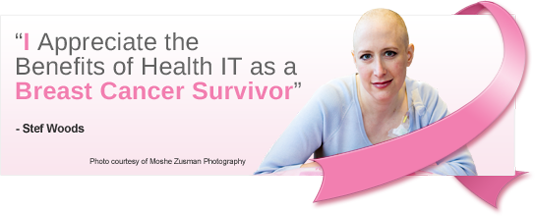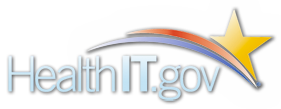Stef Woods


I Appreciate the Benefits of Health IT as a Breast Cancer Survivor
As a 38-year-old breast cancer survivor, Stef Woods is on a mission: Raise awareness that breast cancer can strike at a young age and it can affect men, not just women. That's why she did a photo shoot while undergoing treatment in the chemotherapy room and why she walks the runway in breast cancer awareness fashion shows for Pink Jams! – a nonprofit breast cancer advocacy organization. Ms. Woods was diagnosed in June 2010 with an aggressive form of breast cancer, and it was early detection that is helping her beat the cancer and health information technology (health IT) which helps Ms. Woods and her providers better coordinate her care.
After losing my mom to cancer when I was 24, I worked closely with my doctors to monitor my cancer risks. I had six breast biopsies over the years – luckily all negative. But the summer of 2010, my luck ran out when a biopsy revealed an aggressive form of breast cancer. I was just 37 – far too young to be facing cancer.
I survived Guillain-Barré syndrome and suffer from chronic migraines. With my breast cancer diagnosis and these other medical issues, my health care facilities' use of electronic health records (EHRs) has made coordination of my care manageable and gives me confidence that I am receiving the best care possible across all providers and facilities.
I first noted the use of health IT in my neurologist's office. I walked into her office in December 2007, and rather than a pen and paper to complete my records, she had a laptop. I noticed how easy it made the visit, and things did not get lost in the shuffle of paper. Even better, other doctors were easily apprised of my condition and her recommendations through these electronic records. EHRs made everything clear and ensured that everyone was on the same page.
I also started to notice a trend in terms of scans. When I started to have mammograms in 2008 at age 35, my main health care facility, Sibley Hospital in Washington, DC, had already switched to digital mammography. It is wonderful to have my radiologist pull up my latest mammogram on the computer and compare it to former scans. To have everything accessible electronically, to know what to focus on and what not to focus on, is so helpful in understanding the status of my health and the best next steps for my care.
So many other facilities require women to have their mammogram, go home, and wait to hear the results. Receiving a letter in the mail a week or more later that says there may be an abnormality is unsettling, and the wait is torturous. To have that kind of notification in the same pile as a magazine or junk mail, and to receive it unexpectedly, can be very scary. However, because of Sibley Hospital's health IT, I have my mammogram, and while I'm still at the facility, my providers look at the films online with me. They compare these latest films to the scans from previous mammograms. If additional diagnostic mammograms or a follow-up are needed, they will let me know right then and there.
Care like that is irreplaceable, and I think health IT only increases the high-caliber of service that a hospital like Sibley can provide. The use of EHRs and new technology facilitates my doctors' collaboration, and it lets me rest a little easier every day.
Quite honestly, when technology is available as a resource that can allow medical practitioners to do their job better to the benefit of the patient, there is no reason not to use it. It is cost effective. It is environmentally efficient. It yields better results.
I've been asked if I have concerns about privacy and security of EHRs, but honestly I'm not concerned at all. If there are benefits to be gained that can improve my health through the use of EHRs, I don't foresee a problem at all. There will always be those rare exceptions to the rules, but the benefits of using EHRs overwhelmingly outweigh any potential negative privacy concerns.
Once you've survived cancer or any disease for that matter, the most important thing is monitoring your health moving forward. To have scans, other tests, and everything available electronically makes life as a patient that much easier. Instead of borrowing the film, then taking it to your doctor, then either taking it to another doctor or taking it back to the radiologist, my providers are connected electronically and each have up-to-date scans and tests at their disposal.
As an advocate of early detection, I'm passionate about generating awareness about breast cancer. Through my personal blog and my work as a board member for Pink Jams! – I can encourage younger women and men to think differently about breast health and self examinations.
And one of the most important parts of my role as an advocate is also communicating to those fighting cancer, as well as survivors, that YOU must be your own best health advocate. You must advocate for yourself and encourage the use of health IT to support everyone's role in your treatment. This only enhances the health care that's provided and the patient's ability to focus on what is most important-getting and staying well.
On October 21, 2011, Ms. Woods walked the runway wearing a pink couture gown along with celebrities and other young breast cancer survivors during the Pink Rocks the Runway™ gala, an annual Washington, DC breast cancer awareness fashion event, sponsored by Pink Jams! The annual gala combines couture fashion and live rock music with important breast cancer early detection messages.

